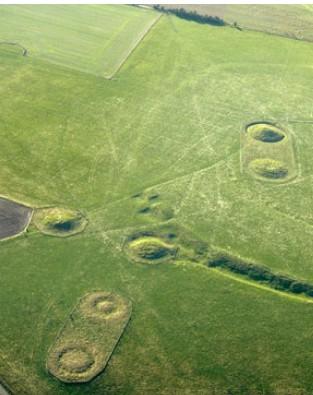
Science and Technology The Neolithic Boom-time machine
科技 新石器時代 時間機器解密:新石器時代的繁榮期
A new technique lets archaeologists reconstruct the past in greater detail
考古新技術讓考古學家們能更加詳盡地重構遠古原貌
THAT economic expansion leads to building booms seems to have been as true 6,000 years ago as it is now.
在經濟擴張時期,人們往往喜歡大興土木。如今的這條經濟定律在6000年前似乎也同樣適用。
When agriculture came to Britain, it led to a surge of construction as impressive—and rapid—as the one that followed the industrial revolution.
隨著農業在英國生根萌芽,建筑業也隨之蓬勃興旺,其發展速度之快,令人印象之深刻毫不遜色于英國工業革命之后的那次農業變革。
Which is all a bit of a surprise to archaeologists, who had previously seen the arrival of the Neolithic as a rather gentle thing.
這一切讓考古學家們顯得有些驚訝,他們之前一直認為新石器時代是經濟發展較為和緩的時期。
But that may be because of the tools they use.
不過這可能是由于他們使用的考古技術方法還不夠先進。
Radiocarbon dating provides a range, often spanning 200 years or more, rather than an exact date for a site.
采用放射性碳技術來測定一處考古遺址的年代,得到的并不是一個準確日期,而是一個時間跨度范圍通常為200年或更久遠的數值。
Stratigraphy, which looks at the soil layers in which artefacts are found, tells you only which ones are older and which younger.
而地層學采用的方法是通過對已發現古代文物的土壤層進行探測分析,從而判斷土壤年代的遠近。
None of these data is precise.
這種方法得出的數據也都不精確。
They do, however, limit the possible range of dates.
然而它們確實縮短了可推算的時間跨度。
And by using a statistical technique called Bayesian analysis it is possible to combine such disparate pieces of information to produce a consolidated estimate that is more accurate than any of its components.
通過貝葉斯分析的統計方法,這些分散孤立的信息可能被整合成一個可靠詳實的估計數值,這比單一研究其中的任何一條信息都更為精確。
That results in a range that spans decades, not centuries.
采用地層學斷代推算出的時間范圍是幾十年,而不是幾百年。
A team led by Alex Bayliss, from English Heritage, a British government agency, has just used this technique to examine digs from hundreds of sites around Britain.
Alex Bayliss領導的研究小組來自于英國政府機構的古跡署,他們剛剛采用這項技術對英國周圍幾百處的人工挖鑿遺址進行了研究。
The results have caused them to reinterpret the Neolithic past quite radically.
這些成果可以讓他們更為徹底地重新詮釋新石器時代。
Agriculture seems to have arrived fully formed in what is now Kent, in the south-east, around 4050BC.
大約在公元前4050年,在現今的英國東南部的肯特郡(Kent),那里的農業時代似乎已經到來并發展成熟。
The new culture spread slowly at first, taking 200 years to reach modern-day Cheltenham, in the west, but over the following five decades it penetrated as far north as Aberdeen.
起初這種新文化傳播緩慢,用了200年的時間才到達今天英國西部的切爾滕納姆(Cheltenham),但是在后續的50年中,它迅速東擴到了北部的阿伯丁(Aberdeen)。
Soon afterwards, causewayed enclosures (circular arrangements of banks and ditches hundreds of metres across—see picture) began springing up all over the country.
隨后,筑有堤道的圍場(其格局為幾百米跨度的環形堤岸與溝渠)開始在全國遍地開花。
Until now, archaeologists had assumed that these were built over the course of centuries.
現在,考古學家斷定這些建筑物是在幾百年間陸續建成的。
Dr Bayliss's work suggests they were the product of two booms, each just a few decades long—for the Neolithic seems to have seen its share of busts, too.
Bayliss博士的考古研究表明它們是兩個繁榮期的產物,每個繁榮期的持續時間僅為幾十年,可見新時器時代似乎也存在過衰落的蕭條期。
The team's work offers such a sharp picture of the past that it is possible to trace the histories even of individual communities, such as one in Essex whose inhabitants built, used and then abandoned an enclosure within the span of a single generation.
考古研究小組為我們展示了清晰的遠古畫面,讓我們可以追溯到更遠的歷史甚至小的個體群落,例如在埃塞克斯(Essex)考古遺址,考古人員發現了當時原始居民修建,使用和后來廢棄的圍場,它伴隨了一代人的成長。
English Heritage now plans to apply the technique to another murky era of British history, the early Anglo-Saxon period between 400AD and 700AD.
現在英國古跡署計劃將此技術應用于英國另一段有著模糊記載的歷史年代,即介于公元400年至公元700年的早期盎格魯-撒克遜時期。
In principle, the method can be applied to any archaeological site, and several groups of researchers around the world are working on similar projects.
理論上,此種方法可以應用于任何一個考古遺址,現在全世界已經有幾組考古人員運用此方法進行著類似的考古項目。
But, fittingly for a discipline that deals in centuries and millennia, the revolution will be a slow one.
但是恰當地說,對一門牽涉幾百年和上千年的學科,它的發展將是一個漫長的過程。
Unlike traditional radiocarbon dating, which can be bought off the shelf, Dr Bayliss reckons it takes between three and four years to train a graduate researcher to use the new technique properly.
傳統的放射碳斷代法是一種現學現賣的技術,但地層學與之不同,Bayliss博士認為培養一名完全掌握此項新技術且具有碩士學位的研究人員得需要三到四年的時間。











